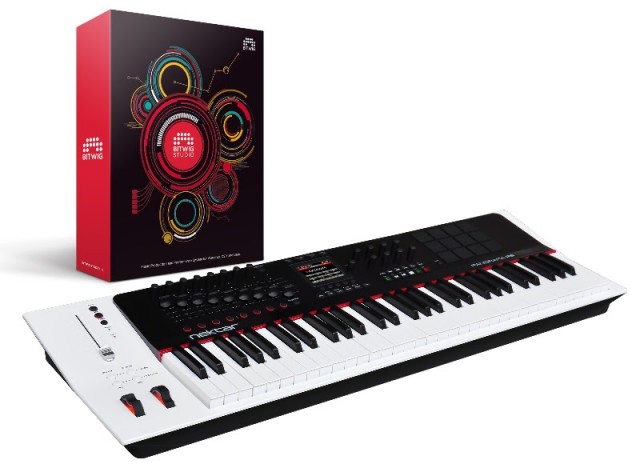The long wait for the new production software Bitwig Studio has created anticipation and exasperation in equal measure – people were excited, people were impatient; some drooled over every tiny feature details, some dismissed them and said they’d wait until it shipped. But the wait is over; today is actually the day Bitwig Studio is something you can download, try out, and buy. It’s not a beta; this is it. 299€ / US$399 buys you the full download version; a demo is available. (Boxed versions cost more.)
So, what can you expect on today as release day?
Well, at least Bitwig has enlisted some significant third-party support.
There’s hardware controller support, from Novation’s Launchpad, for instance. At Musikmesse this month, we saw hardware integration from Livid Instruments and (newly-debuted) support from the beautiful Panorama keyboards. The latter means a keyboard that integrates directly with the workflow of the software, with Bitwig joining Reason, Cubase, and Logic. Here’s a look at how that works with the very-pretty Nektar (and that installer just went live today, too):
The hardware support is partly thanks to an easier-to-script API for controllers. We’ve seen equivalents of that in software like Renoise and Reaper, but it’s notably a more difficult task to customize in most DAWs, including Ableton Live.
There’s also training available on day one, including askvideo.com, with producer Olav Basoski doing a complete 10-tutorial video course.
But that leaves the question of the actual product. I’ll be testing it. I’m actually quite looking forward to it, and know some others who feel the same way, not necessarily in that I expect to dump tools I’ve used for years, but because I find it refreshing to explore new tools.
I don’t think that’s true of everyone, though; Bitwig will likely face the uphill battle any new DAW maker has in setting their product apart – and even in getting people to know about it.
Sound on Sound did an interview with Bitwig at their booth at Messe, in which the creators talked about their perspective.
To me, the most interesting part of Bitwig is something we still won’t see today. Every effect, every instrument is built in a modular environment they’ve constructed. That approach has borne fruits – you can use the stuff they’ve built. But you can’t yet use the modular guts; that’s promised for a future release.
What you do get are some features that have a slightly more niche appeal, but that some enthusiast producers may find attractive. Bitwig has outlined them on their page, but here’s what I think is most important:
1. Linux support, in addition to OS X and Windows. Linux users have had Renoise (and some have made use of Reaper inside a Windows compatibility environment), but this is a big deal.
2. A modulation environment for everything. Okay, so it’s not modular yet – you don’t get this sort of Reaktor-inside-Ableton feeling of having a complete modular tool. But you do get semi-modular control of everything in sight, with some powerful tools for authoring complex sound designs.
3. Controller scripting. There’s no Bitwig-manufactured hardware as there is Ableton’s Push or Native Instruments’ Maschine. Instead, what you find is an easy way to build controller support, as the above examples illustrate. That’s important for any environment that emphasizes live playing, and I’m curious to try it out.
4. A refined interface. The comparison is obviously here strongly to Ableton Live, especially with four ex-Ableton employees founding the company. One thing Ableton lacks is a clean-slate tool; they started around 1999 instead of Bitwig in 2009. Bitwig therefore has some interface elements specific to their approach (like inspectors), and some Ableton users have asked for (like side-by-side clip launching and arrangement, or multiple projects open at once).
None of these to me is a radical departure from what’s in the market, but it is worth testing, and we’ll do that.
Here’s Full Compass with a look at how the workflow comes together:
You’ll see some things aren’t on the list. There isn’t a fusion of DJ-style waveform previews with this environment. There isn’t much departure from the central clip paradigm of Ableton Live. There’s no use of mobile, or touch, or truly-scalable user interfaces.
So, I think the real question is whether any of this matters much beyond a small-but-loyal enthusiast community who get deep in this sort of production software. But I’ll give it a test both from my own ‘enthusiast’ perspective and to see if it might matter beyond our niche, and we’ll see how people respond now that it’s in the market.
We’d love to know what you think, and what you’d like to know.
It also seems time to look at some other “underground” DAW rivals, like PreSonus Studio One or the latest version of Renoise.
But I’ll say this: the era of desktop software for music is far from over. There are still intense rivalries and an insane embarrassment of variety. And whether you’re impressed by those offerings or not, I think we’re blessed to work in a community of musicians so idiosyncratic in their tastes. There isn’t just one (cough) creative suite for making music. They just keep breeding. And that’s good news for those of us who enjoy playing with them.
